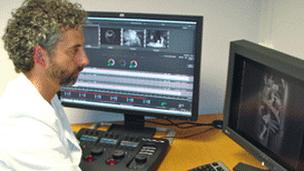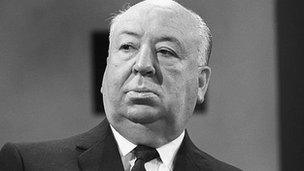Olympian effort behind the saving of the Hitchcock nine
- Published
The Pleasure Garden gives an insight into Hitchcock's later stylistic devices
The British Film Institute (BFI) is celebrating the work of film-maker Alfred Hitchcock with a season of screenings, including nine of his little-known silent movies, restored to their original glory after a painstaking and time-consuming restoration project. We went behind the scenes to see the meticulous work of the BFI conservationists.
The instantly recognisable figure of Alfred Hitchcock stares out from a giant outdoor poster at this year's Cannes Film Festival.
His jowly face is twisted into a grimace. His index finger points accusingly. More than 30 years after his death, Hitchcock remains one of the towering icons of cinema history.
Taut 1950s and 1960s thrillers such as Rear Window, North by Northwest, Vertigo and Psycho sealed his reputation as "the master of suspense". Hitchcock's early silent films, though, are often excluded from the canon.
For decades, screenings have been limited to festival audiences and small groups of cinema enthusiasts. That is about to change.
The British Film Institute (BFI) has spent three years restoring nine Hitchcock films made between 1925 and 1929. They will be shown at a series of gala events as part of the <link> <caption>London 2012 Festival</caption> <altText>London 2012 Festival </altText> <url href="http://festival.london2012.com/" platform="highweb"/> </link> taking place alongside the Olympic Games.
"We've been trying to show them for years and we were always frustrated by the condition they were in," says Robin Baker, head curator of the BFI's National Archive at Berkhamsted, Hertfordshire.

Film frames were restored and edited using computer software
"It feels so appropriate at a time when the world's focus is on London that Britain's greatest film-maker, who was born in one of the Olympic boroughs and who made films about London, will be one of the stars."
The restoration process began with a worldwide search for surviving prints of the nine titles. A tenth film made during the period, The Mountain Eagle (1926), remains lost.
Once the fragile reels, some of them made from unstable and highly flammable nitrate film stock, were located and sent to the BFI's National Archive, they were examined and logged shot-by-shot by film restoration experts.
Detective work
It was commonplace in the early years of cinema for versions of a film to be different from country to country.
With no surviving scripts or original camera negatives to work from, however, the restoration team turned detective to help decide what Hitchcock's original vision for each film might have been.
"It's a matter of building up evidence," explains the BFI's Film Conservation Manager, Kieron Webb.
"The way films were produced during the period leaves its mark and you can make judgements about when and perhaps why edits were made.
"You can date the prints and that can help you work out what the film was like on its first release and what was a later change added by someone else."
After being checked, cleaned and repaired if necessary, each frame of film was digitally captured on a £500,000 scanner before being restored and edited using computer software.
Familiar themes
Hitchcock's unique style is apparent even in his earliest films.
The restored works show him beginning to explore some of the signature motifs that were to recur throughout his career.
"The very first shot of The Pleasure Garden, which was made in 1926, features a chorus line of blonde women walking down a spiral staircase," says Baker.
"They come out onto a stage and they are leered at by a group of middle-aged men staring at them through opera glasses.
"Already you have the obsession with blondes seen in The Birds and North by Northwest, the voyeurism of Psycho and Rear Window, even the theatre setting he used again and again in his films," he continues.
"If you went through a checklist of things we describe as 'Hitchcockian' you could tick off about half of them straight away," he adds.
"Hitchcock knew what he was interested in and how he was going to pursue it from day one."
Even before the birth of talking pictures, sound was an integral part of the cinema-going experience.
"At the time it was indispensable - nobody would have thought about silent film without its other component, which was the music," says the BFI's curator of silent film, Bryony Dixon.
During the 1920s, orchestra leaders at individual cinemas would have written a score to accompany each film.
With no original music manuscripts to draw from, the BFI has commissioned scores from leading contemporary British artists such as Soweto Kinch, Mira Calix and Nitin Sawhney.
The new soundtracks will be performed live at each screening.

Hitchcock pioneered camera techniques which are still practised today
"There's a big debate about whether you update the music for a modern audience," admits Dixon.
"It's a performance and it's the connection between the visuals and the audience through music that's important.
"If the audience has different expectations than a 1920s audience would have had I think it's fine to reinterpret the music."
New generation
In addition to the nine restored works, a major Alfred Hitchcock retrospective encompassing all of his surviving films will be held at the BFI Southbank in London between August and October.
The BFI hopes the Hitchcock season will burnish the Leytonstone-born film-maker's reputation as a central figure in British artistic and cultural history - and also introduce him to a new generation of film fans.
"There's a similarity between Hitchcock and Charles Dickens, who wrote incredibly commercial, popular novels but also created some of the most brilliant literature ever written in this country," says Baker.
"Hitchcock did exactly the same thing. He created an incredibly commercial, popular cinema but he did it with a profound artistry.
"Too many people still see film as a disposable art form but if you analyse what Hitchcock was doing you can understand the genius at work.
"I think he's at the top of any list of the most important creative artists Britain has ever produced."
<italic>The Genius of Hitchcock season opens on Friday 6 July with the world premiere of the restored 1929 film Blackmail at the British Museum in London.</italic>
- Published17 April 2012
- Published4 July 2011